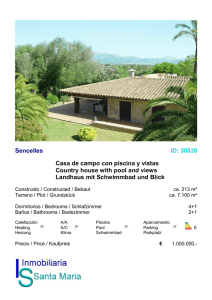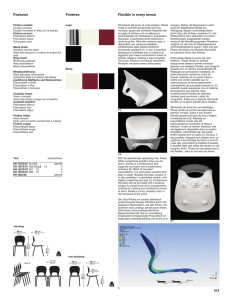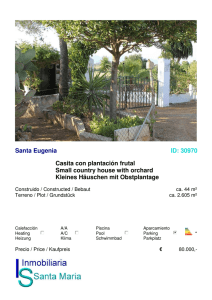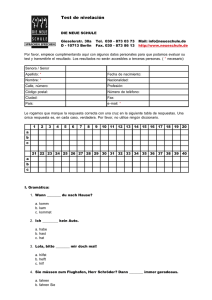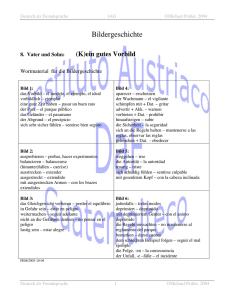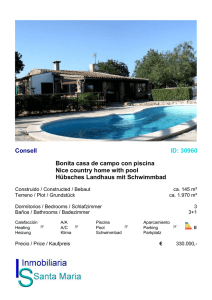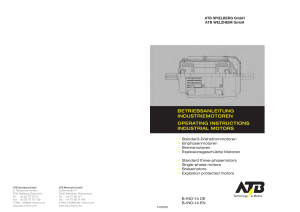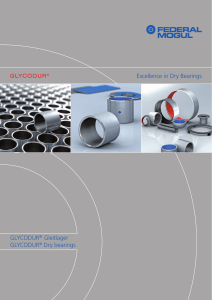GST 10.1 – GST 40.1
Anuncio
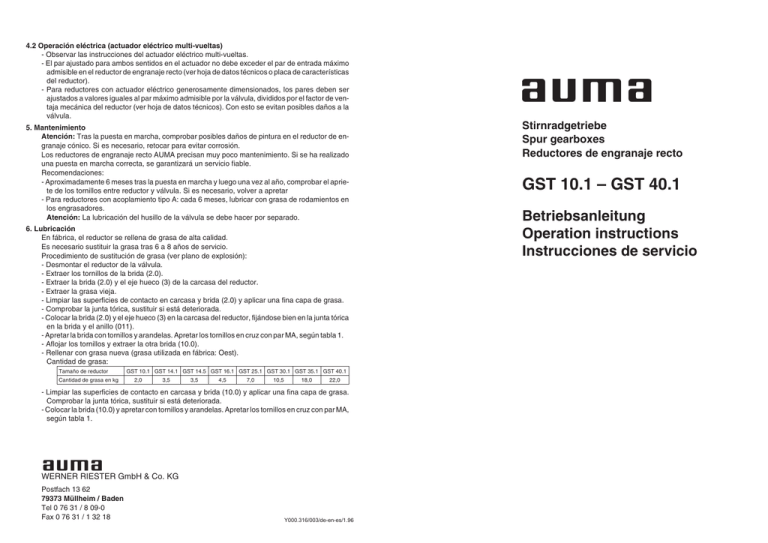
4.2 Operación eléctrica (actuador eléctrico multi-vueltas) - Observar las instrucciones del actuador eléctrico multi-vueltas. - El par ajustado para ambos sentidos en el actuador no debe exceder el par de entrada máximo admisible en el reductor de engranaje recto (ver hoja de datos técnicos o placa de características del reductor). - Para reductores con actuador eléctrico generosamente dimensionados, los pares deben ser ajustados a valores iguales al par máximo admisible por la válvula, divididos por el factor de ventaja mecánica del reductor (ver hoja de datos técnicos). Con esto se evitan posibles daños a la válvula. 5. Mantenimiento Atención: Tras la puesta en marcha, comprobar posibles daños de pintura en el reductor de engranaje cónico. Si es necesario, retocar para evitar corrosión. Los reductores de engranaje recto AUMA precisan muy poco mantenimiento. Si se ha realizado una puesta en marcha correcta, se garantizará un servicio fiable. Recomendaciones: - Aproximadamente 6 meses tras la puesta en marcha y luego una vez al año, comprobar el apriete de los tornillos entre reductor y válvula. Si es necesario, volver a apretar - Para reductores con acoplamiento tipo A: cada 6 meses, lubricar con grasa de rodamientos en los engrasadores. Atención: La lubricación del husillo de la válvula se debe hacer por separado. 6. Lubricación En fábrica, el reductor se rellena de grasa de alta calidad. Es necesario sustituir la grasa tras 6 a 8 años de servicio. Procedimiento de sustitución de grasa (ver plano de explosión): - Desmontar el reductor de la válvula. - Extraer los tornillos de la brida (2.0). - Extraer la brida (2.0) y el eje hueco (3) de la carcasa del reductor. - Extraer la grasa vieja. - Limpiar las superficies de contacto en carcasa y brida (2.0) y aplicar una fina capa de grasa. - Comprobar la junta tórica, sustituir si está deteriorada. - Colocar la brida (2.0) y el eje hueco (3) en la carcasa del reductor, fijándose bien en la junta tórica en la brida y el anillo (011). - Apretar la brida con tornillos y arandelas. Apretar los tornillos en cruz con par MA, según tabla 1. - Aflojar los tornillos y extraer la otra brida (10.0). - Rellenar con grasa nueva (grasa utilizada en fábrica: Oest). Cantidad de grasa: Tamaño de reductor Cantidad de grasa en kg GST 10.1 GST 14.1 GST 14.5 GST 16.1 GST 25.1 GST 30.1 GST 35.1 GST 40.1 2,0 3,5 3,5 4,5 7,0 10,5 18,0 22,0 - Limpiar las superficies de contacto en carcasa y brida (10.0) y aplicar una fina capa de grasa. Comprobar la junta tórica, sustituir si está deteriorada. - Colocar la brida (10.0) y apretar con tornillos y arandelas. Apretar los tornillos en cruz con par MA, según tabla 1. WERNER RIESTER GmbH & Co. KG Postfach 13 62 79373 Müllheim / Baden Tel 0 76 31 / 8 09-0 Fax 0 76 31 / 1 32 18 Y000.316/003/de-en-es/1.96 Stirnradgetriebe Spur gearboxes Reductores de engranaje recto GST 10.1 – GST 40.1 Betriebsanleitung Operation instructions Instrucciones de servicio Bild / figure 1 / figura 1 Bild / figure 2 / figura 2 Los reductores de engranaje recto AUMA son dispositivos mecánicos de alto valor. Si se observan las siguientes instrucciones, se podrán evitar posibles daños: 1. Transporte y almacenamiento - Transportar al lugar de instalación en embalaje resistente. - No atar cuerdas al volante para elevación. - Almacenar en salas bien ventiladas y secas. - Proteger contra la humedad del suelo almacenando en estanterías o palets de madera. - Cubrir para proteger contra polvo y suciedad. - Aplicar agente anti-corrosión a las superficies mecanizadas. 2. Condiciones de servicio Los reductores de engranaje recto AUMA, en versión estándar, son adecuados para temperatura ambiente desde - 20 °C hasta + 80 °C. Están diseñados para servicio reducido S 2 - 15 minutos (según VDE 0530). 3. Montaje a la válvula Los reductores pueden ser montados y operados en cualquier posición. - Comprobar que la brida de acoplamiento coincide con la de la válvula. Atención: Efectuar centraje de bridas con juego. Para acoplamiento tipo A, la rosca tiene que coincidir con la del husillo de la válvula. Si no se pide explícitamente roscada, la tuerca se suministra en bruto o pre-taladrada. Mecanización de la tuerca, ver punto 3.1. - Los acoplamientos tipo B1, B2, B3 ó B4 se suministran con orificio y chavetero (normalmente según ISO 5210) - Comprobar que el orificio y chavetero coinciden con el eje de la válvula. - Desengrasar completamente las superficies de contacto entre reductor y válvula. - Aplicar un poco de grasa no ácida al eje de la válvula. - Colocar el reductor sobre la válvula; apretar con tornillos (min. 8.8) firmemente en cruz. 80.00 80.00 80.00 80.00 80.2 Bild / figure 3 / figura 3 max. zulässiges Drehmoment max. permissible torque par máximo admisible Drehmoment torque par Belastungsfall I load characteristic I característica de carga I 0% Belastungsfall II load characteristic II característica de carga II Stellweg travel carrera Tabelle / table / tabla 1 8.8 M 6 M 8 M 10 M 12 M 16 M 20 M 30 2 MA (Nm) 10 25 49 86 210 410 1450 100 % 3.1 Mecanización de la tuerca de roce (acoplamiento tipo A). Figura 2 No es necesario desmontar la brida de acoplamiento del reductor. - Extraer el anillo de centraje (80.2) mediante una llave de medio punto o similar. - Extraer la tuerca (80.3) junto con los rodamientos (80.001) y pistas de rodamientos (80.002). - Separar rodamientos y pistas de la tuerca. - Tornear y roscar la tuerca (80.3). Atención: Al fijar en el torno, comprobar giro y cabeceo. - Limpiar la tuerca mecanizada. - Lubricar los rodamientos y pistas (80.002) con grasa adecuada y montar en la tuerca (80.3). - Montar la tuerca (80.3) en la brida. Comprobar que las garras estén ajustadas correctamente en las ranuras del eje hueco. - Roscar el anillo de centraje (80.2) y apretar a tope. - Lubricar con una pistola en el engrasador. 4. Maniobra de válvulas Atención: El par máximo de salida (ver hoja de datos técnicos y placa de características del reductor) se refiere al máximo valor, no permitido durante todo el recorrido (ver figura 3). 4.1 Mando manual - Para el mando manual se puede utilizar un volante o una extensión de eje. - El reductor está preparado para recibir una brida de acoplamiento para un actuador multi-vueltas. 7 4.2 Motor operation (electric multi-turn actuator) - Observe operation instructions of multi-turn actuator. - Setting of torque switching in multi-turn actuator for both directions should not exceed max. permissible input torque of gearbox (refer to technical data sheet or nameplate at spur gearbox). - For generously sized gearboxes with multi-turn actuator, the torque switchings must be set to value equal to max. permissible torque of valve, divided by “factor” (refer to technical data sheet). This is to avoid possible damages to the valve. 5. Maintenance Attention: Check spur gearbox after commissioning for damages on paint caused during transport or installation. Do necessary touch-up to prevent corrosion. AUMA spur gearboxes require only little maintenance. Precondition for reliable service is correct commissioning. We recommend: - Approximately 6 months after commissioning and then every year check bolts between gearing and valve for tightness. If required retighten. - Spur gearboxes with output drive form A: At intervals of approx. 6 months press in several strokes of ball bearing grease at the lubricating nipple with grease gun. Attention: Lubrication of the valve stem must be done separately. 6. Lubrication Gear housing has been filled with lubricant at factory. Changing of grease is necessary after about 6 to 8 years service. Changing of grease (refer to exploded view/ list of spare parts): - Gearbox has to be removed from the valve. - Remove bolts at bearing flange (2.0). - Remove bearing flange (2.0) together with hollow shaft from gearbox housing. - Remove old grease. - Clean mounting surfaces at housing and bearing flange (2.0) and apply thin film of grease. - Check o-ring, exchange if damaged. - Place bearing flange (2.0) together with hollow shaft (3) in gearbox housing, paying attention to o-ring at bearing flange and quad ring (011) in housing. - Fasten bearing flange with bolts and spring washers. Tighten bolts cross-wise with torque MA according to table 1. - Loosen bolts and remove other bearing flange (10.0). - Fill in new grease (grease used in factory: Oest). Quantity of grease: Gearbox size Quantity of grease in kg GST 10.1 GST 14.1 GST 14.5 GST 16.1 GST 25.1 GST 30.1 GST 35.1 GST 40.1 2,0 3,5 3,5 4,5 7,0 10,5 18,0 22,0 - Clean mounting surfaces at gearbox housing and bearing flange (10.0) and apply thin film of grease. Check o-ring, exchange if damaged. - Place bearing flange (10.0) and fix with bolts and spring washers. Fasten bolts cross-wise with torque MA according to table 1. AUMA Stirnradgetriebe sind hochwertige, mechanische Geräte. Schäden daran können bei Beachtung nachstehender Punkte vermieden werden. 1. Transport und Lagerung - Transport zum Aufstellungsort in fester Verpackung. - Hebezeug nicht am Handrad befestigen. - Lagerung in gut belüftetem, trockenem Raum. - Schutz gegen Bodenfeuchtigkeit durch Lagerung im Regal oder auf Holzrost. - Abdeckung zum Schutz gegen Staub und Schmutz. - Blanke Flächen mit geeignetem Korrosionsschutzmittel behandeln. 2. Betriebsbedingungen AUMA Stirnradgetriebe in Standardausführung sind geeignet für Betrieb bei Umgebungstemperaturen von – 2 0 °C bis + 80 °C. Sie sind ausgelegt für Kurzzeitbetrieb S2 - 15 min (nach VDE 0530). 3. Anbau an die Armatur Anbau und Betrieb kann in jeder beliebigen Lage erfolgen. - Prüfen, ob Anschlußflansch zur Armatur paßt. Achtung: Zentrierung der Flansche als Spielpassung ausführen! Bei Anschlußform A muß Gewinde mit Armaturenspindel übereinstimmen. Falls nicht ausdrücklich mit Gewinde bestellt, ist die Gewindebuchse bei Auslieferung vom Werk ungebohrt bzw. vorgebohrt. Fertigbearbeitung der Gewindebuchse siehe Punkt 3.1. Die Anschlußformen B1, B2, B3 oder B4 werden mit Bohrung und Nut (in der Regel nach ISO 5210) geliefert. - Prüfen, ob Bohrung und Nut mit Eingangswelle von Armatur übereinstimmen. - Auflageflächen der Anschlußflansche an Stirnradgetriebe und Armatur gründlich entfetten. - Eingangswelle von Armatur leicht einfetten. - Stirnradgetriebe auf Armatur aufstecken und befestigen. Schrauben (min. Qualität 8.8) gleichmäßig über Kreuz anziehen. 3.1 Fertigbearbeitung der Gewindebuchse, Anschlußform A (siehe Bild 2) Abtriebsflansch muß dazu nicht vom Stirnradgetriebe abgenommen werden. - Zentrierring (80.2) mit Hilfe eines Zapfenschlüssels oder ähnlichem aus Anschlußflansch herausdrehen. - Gewindebuchse (80.3) zusammen mit Axial-Nadelkranz (80.001) und Axial-Lagerscheiben (80.002) herausnehmen. - Axial-Nadelkranz (80.001) und Axial-Lagerscheiben (80.002) von Gewindebuchse (80.3) abnehmen. - Gewindebuchse (80.3) bohren, ausdrehen und Gewinde schneiden. Achtung: Beim Einspannen auf Rund- und Planlauf achten! - Fertig bearbeitete Gewindebuchse reinigen. - Axial-Nadelkranz (80.001) mit Axial-Lagerscheiben (80.002) mit Kugellagerfett schmieren und auf Gewindebuchse (80.3) aufstecken. - Komplette Gewindebuchse (80.3) wieder in Anschlußflansch einsetzen. Darauf achten, daß Klauen richtig in Nut der Hohlwelle eingreifen. - Zentrierring (80.2) einschrauben und bis zum Anschlag festdrehen. - Am Schmiernippel mit Fettpresse mehrere Hübe Kugellagerfett einpressen. 4. 6 Betätigung von Armaturen Achtung: Das max. Abtriebsmoment (siehe Technisches Datenblatt oder Typenschild am Stirnradgetriebe) bezieht sich auf Spitzenwerte und darf nicht über den gesamten Stellweg abgenommen werden (siehe Bild 3). Rechtsdrehung an der Eingangswelle ergibt Rechtsdrehung am Abtrieb. 4.1 Betätigung im Handbetrieb - Kann direkt mit Handrad oder durch Fernantriebsgestänge erfolgen. - Getriebe ist vorbereitet für Anbau von Flansch für Drehantriebe. 3 4.2 Betätigung im Motorbetrieb (elektrischer Drehantrieb) - Bei Betrieb mit elektrischem Drehantrieb ist die jeweilige Betriebsanleitung des Drehantriebes zu beachten. - Die Einstellung der Drehmomentschalter im Drehantrieb darf für beide Richtungen das max. zulässige Eingangsmoment des Getriebes (siehe Technisches Datenblatt oder Typenschild am Stirnradgetriebe) nicht überschreiten. - Bei großzügig dimensioniertem Getriebe und Drehantrieb sind die Drehmomentschalter auf das max. zulässige Moment der Armatur, geteilt durch “Faktor” (siehe Technisches Datenblatt) einzustellen, um diese vor Schaden zu schützen. AUMA spur gearboxes are high value, mechanical devices. Possible damages can be avoided by observing the following points. 1. Transport and storage - Transport to place of installation in sturdy packing - Do not attach to the handwheel ropes or hooks to lift by hoist. - Store in well ventilated, dry room. - Protect against humidity from the floor by storage on shelf or on wooden frame. - Cover to protect against dust and dirt - Apply suitable corrosion preventive to bright surfaces. 5. 2. Service conditions AUMA spur gearboxes in standard version are suitable for ambient temperature from – 20 °C to + 80 °C. They are rated for short-time duty S 2 - 15 minutes (according to VDE 0530). 3. Mounting to the valve Mounting and operation can be in any position. - Check whether output drive flange suits the valve. Attention: Spigot at flanges should be loose fit! For output drive form A, the thread must correspond with thread of the valve stem. The stem nut is supplied unbored or with pilot bore, if not ordered explicitly with thread. For machining the stem nut refer to point 3.1. - Output drive forms B1, B2, B3 or B4 are supplied with bore and keyway (usually according to ISO 5210). - Check whether bore and keyway correspond with the input shaft of the valve. - Degrease mounting surfaces at spur gearbox and valve thoroughly. - Apply thin film of grease to input shaft of valve. - Place spur gearbox on valve and fasten with bolts (min. quality 8.8) firmly cross-wise. Wartung Achtung: Nach der Inbetriebnahme Stirnradgetriebe auf Lackschäden, verursacht bei Transport oder Anbau, prüfen. Schäden sorgfältig ausbessern, um Korrosionsbildung zu vermeiden. AUMA Stirnradgetriebe benötigen nur sehr geringe Wartung. Voraussetzung für zuverlässigen Betrieb ist richtige Inbetriebnahme. Wir empfehlen: - Etwa sechs Monate nach Inbetriebnahme und dann jährlich die Befestigungsschrauben zwischen Getriebe und Armatur auf festen Anzug zu prüfen. Falls erforderlich nachziehen. - Bei Stirnradgetrieben mit Anschlußform A in Intervallen von ca. sechs Monaten mit Fettpresse am Schmiernippel mehrere Hübe Kugellagerfett einpressen. Achtung: Schmierung der Armaturenspindel muß separat erfolgen. 6. Schmierung Im Werk wurde das Getriebe mit Schmierstoff gefüllt. Ein Fettwechsel wird nach ca. 6 - 8 Jahren erforderlich. Fettwechsel (siehe Explosionszeichnung/Ersatzteilliste): - Dazu muß das Getriebe von der Armatur abgebaut werden. - Schrauben am Lagerflansch (2.0) der Hohlwelle entfernen. - Lagerflansch komplett (2.0) mit Hohlwelle (3) aus Getriebegehäuse herausnehmen. - Altes Fett entfernen. - Anlageflächen am Gehäuse und Lagerflansch (2.0) säubern und leicht einfetten. Runddichtring prüfen, falls schadhaft durch neuen ersetzen. - Lagerflansch komplett (2.0) mit Hohlwelle (3) in Getriebegehäuse einbauen, dabei auf Dichtring am Lagerflansch und Quadring (011) im Gehäuse achten. - Lagerflansch mit Schrauben und Federringen befestigen. Schrauben mit Drehmoment MA gemäß Tabelle 1 über Kreuz anziehen. - Schrauben am Lagerflansch (10.0) der Eingangswelle entfernen und Lagerflansch (10.0) abnehmen. - neues Fett einfüllen (im Werk verwendetes Fett: Oest). Fettmenge: Getriebe Fettmenge in kg GST 10.1 GST 14.1 GST 14.5 GST 16.1 GST 25.1 GST 30.1 GST 35.1 GST 40.1 2,0 3,5 3,5 4,5 7,0 10,5 18,0 22,0 - Anlageflächen am Gehäuse und Lagerflansch (10.0) säubern und leicht einfetten. Runddichtring prüfen, falls schadhaft ersetzen. - Lagerflansch 10.0 aufsetzen und mit Schrauben und Federringen befestigen. Schrauben mit Drehmoment MA gemäß Tabelle 1 über Kreuz anziehen. 4 3.1 Machining of stem nut, output drive form A (refer fig. 2) Mounting flange need not be taken off the spur gearbox. - Remove bearing lock nut (80.2) with help of wrench or similar tool. - Take off stem nut (80.3) together with thrust bearing (80.001) and thrust bearing races (80.002). - Remove thrust bearing and races from stem nut. - Drill and bore stem nut (80.3), cut the thread. Attention: When fixing in the chuck make sure stem nut runs true. - Clean the machined stem nut. - Apply ball bearing grease to thrust bearing and races (80.002) and place them on stem nut (80.3). - Put stem nut (80.3) into mounting flange. Take care that dogs are placed correctly in the slots of the hollow shaft. - Screw in bearing lock nut (80.2) till it is firm against the shoulder. - Press a few strokes of grease with a grease gun into the grease nipple. 4. Operating of valves Attention: The max. output torque (refer to technical data sheet and name plate at spur gearbox) refers to peak values and should not be required over the full travel (fig. 2). Clockwise rotation at input shaft results in clockwise rotation at output shaft. 4.1 Manual operation For manual drive either handwheel or extension shaft can be used. - Gearbox is ready to receive mounting flange for multi-turn actuator. 5
